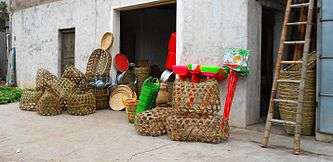Fish in Chinese mythology

Fish are an important motif in Chinese mythology. There are various myths involving fish. The word for "fish", yu is a homophone for "abundance" and "affluence". (Eberhard, 1983: 106). Chinese mythology refers to those myths found in the historical geographic area of China. The geographic area of "China" is of course a concept which has evolved of changed through history. Fish in Chinese mythology include myths in Chinese and other languages, as transmitted by Han Chinese as well as other ethnic groups (of which fifty-six are officially recognized by the current administration of China). (Yang 2005:4) The Chinese dragon is the head of the fish clan.
Character
The Chinese character for fish: traditional Chinese: 魚; simplified Chinese: 鱼; pinyin: yú. Pronounced with a different accent in modern Chinese, 裕 (yù) means "abundance". Due to the homophony, "fish" mythically becomes equated with "abundance".
Evolution
The character for fish (魚) evolved from an ancient pictograph. It is the traditional 195th (out of 216) traditional radical. Over time, the pictographic representations tended to become increasingly stylized, until evolving to the modern standard form:
| script type | example |
|---|---|
| Oracle script | |
| Bronzeware script | |
| Great seal script | |
| Seal script | |
Carp
Carp (traditional Chinese: 鯉; simplified Chinese: 鲤; pinyin: lǐ) can be transformations of dragons, or carp can sometimes change into dragons. According to tradition, a carp that could leap the falls of the Yellow River at Dragon Gate, would be transformed into a dragon: this motif symbolizes success in the civil service examinations. (Eberhard, 1983:57-58) Dragon Gate, at the border of Shanxi and Shaanxi, is where the river flows through a cleft in the Longmen mountains, supposedly made by Yu the Great. According to one account, all the carp competed at a yearly competition to leap the Longmen falls, those who succeeded were immediately transformed into dragons, and flew off into the sky. (Christie, 1968: 65 and 74) Pictures of Carp attempting to leap the Longmen falls have been enduringly popular in China.
Related
Related to fish, some Chinese mythological motifs involve fishermen or fish baskets or a fish trap.
Fisherman
Fuxi
According to Chinese myth, the culture hero Fuxi invented fishing, after the Great Flood (Eberhard, 1983:107). A story tells that first Fuxi fished with his hands, but after observing a spider catching insects in its web, he invented the rattan net and used it to catch fish, which skill he passed on to his descendents (Yang, 2005: 120).
Taigong
Jiang Ziya, the great general and strategist and military mastermind who was key to establishing the Zhou Dynasty, was said to have spent years in his old age fishing, but with a straight hook, or no bait, or with his hook dangling above the water: but, he was fishing for a Lord, not a fish. After Jiang Ziya became the general, he was known as "Taigong", or "the Grand Duke". The degree to which this qualifies as a myth is open to question, but it is certainly a well-known motif.
Fish basket
According to Chinese myth, Fuxi also invented the fish basket, or trap, by weaving bamboo into a cage which had a funnel opening, that was easy for the fish to enter because the big opening was on the outside, but inside it tapered to narrow and exit opening, so it was easy for the fish to get in, but hard to get out. (Eberhard, 1983:108). In other cases the fish basket served more as a net, in which a fish could be scooped from the water and transported to the market. In one manifestation, Guanyin is pictured as holding a fish basket. This imagery is sometimes considered to have a sexual connotation.
Gallery
-
Mongolian bamboo fish basket. Tools and utensils in the Yunnan Nationalities Museum, Kunming, Yunnan, China.
-
Dai bamboo fish basket. Tools and utensils in the Yunnan Nationalities Museum, Kunming, Yunnan, China.
-

Guanyin of the fish basket - attributed to Zhao Meng Fu Yuan dynasty.
-

Baskets in Haikou: the flat baskets at center are for holding small fish or shrimp.
See also
References
- Christie, Anthony (1968). Chinese Mythology. Feltham: Hamlyn Publishing. ISBN 0600006379.
- Eberhard, Wolfram (2003 [1986 (German version 1983)]), A Dictionary of Chinese Symbols: Hidden Symbols in Chinese Life and Thought. London, New York: Routledge. ISBN 0-415-00228-1
- Yang, Lihui, et al. (2005). Handbook of Chinese Mythology. New York: Oxford University Press. ISBN 978-0-19-533263-6